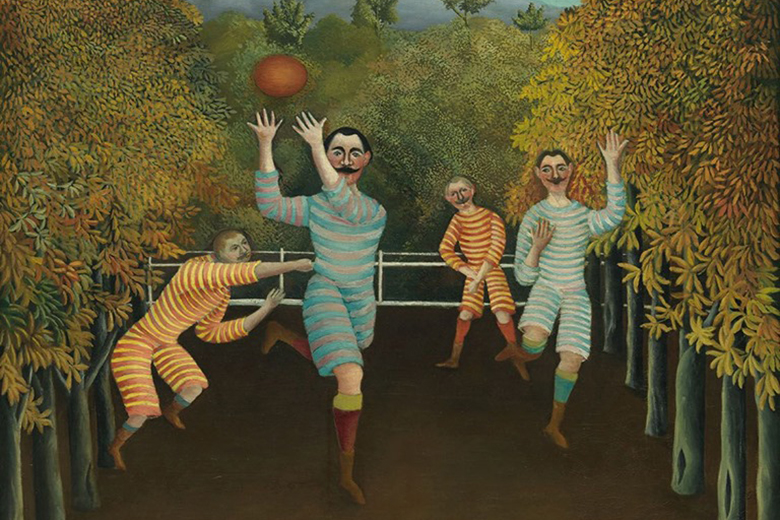Art Loving members of the Ticino BRA made their way to Milan, climbed the palatial stone staircase of the Palazzo Reale, passed through ceiling to floor curtains, along darkened bejewelled lit corridors, feeling a bit like Alice, as the world became smaller and spaces more intimate. We had come to see a Modern Private Art Collection, to be shown for the first time in Europe since it was given to the Solomon R. Guggenheim Museum in New York.
The write up said it was extraordinary and it was, because every painting was a masterpiece by a famous artist. It was jaw dropping, like a role call through modern art history, from the 1800s through the 1900s. Of the Impressionists, (a move away from classic subjects to real life) were paintings from Manet, Monet, and Renoir with sculptures by Degas. The Post-Impressionists (reacting against realism) were represented by Paul Cézanne, Henri Rousseau, George Seurat and Gauguin. Most famous of these Expressionists, (the distortion of reality, expressing emotion) was to be seen in three works by Vincent van Gogh. One was peaceful „Walk in the Snow“ 1888 Arles. The last part of the exhibition covered some of the earliest and latest works chronologically, re-presenting Abstract and Non-Objective art. (This is when the image on canvas is most non re-presentational of the real world, sometimes figurative, bright colours with careful execution, some cubist and fragmented). These styles were to be seen in the works by Georges Braque and those members of « Der Blaue Reiter school », Kandinsky, Klee, Robert Delaunay and Franz Marc. I liked his „Yellow Cow 1911“. Special attention was given to 13 works on display from Pablo Picasso, who had shared a close friendship with Justin K. Thannhauser our collector, from 1913. A particular favorite painting was ‘The Lobster and the Cat’ which was given to Thannhauser as a wedding gift upon his second marriage in 1965. There was something there for everyone’s taste as our group attested to when asked afterwards. No one individual had chosen the same favorite painting.
The Thannhauser story is a moving one, of two generations of a German-Jewish family, who began dealing in Art in Munich in 1905. Heinrich Thannhauser the father and Justin, his son, expanded their business to have galleries in Paris, Berlin and Lucerne. It is a story of the importance of relationships between the art dealer and the artist. They encouraged and promoted artists by displaying their works and dealing on their behalf. They especially promoted the French and German schools of Art of the day. They helped with the development of Art Galleries on the international stage, by criss-crossing the Atlantic from Europe to the Americas in the twentieth Century with exhibitions. It was a family story not without its tragedy. The family left Europe for America in 1937 just before WW II broke out where they continued to deal in art. However, they subsequently lost their property still in Europe. This was followed by the death of both Justin‘s sons, Heinz in 1944 in Italy, who had joined up. The other son Michel, committed suicide in 1952, his wife Kàthé dying in 1960. Although, he had a happy second marriage with Hilde, who shared his passion for art, his losses were part of the reasoning process behind Justin K. Thannhauser’s altruistic gesture in later life. He bequeathed the collection to the Solomon R. Guggenheim Foundation in New York in 1963. With nobody to carry on, he gave his priceless family paintings for others to appreciate and value as his family had done. After having devoted a lifetime to its creation and preservation, he died in 1976 survived by Hilde who died 1991.
Saturated visually by the sheer calibre of works on canvas just viewed, it made our subsequent visit to the Van Cleef & Arpels exhibition of jewellery rather hard to take in. It was equally opulent in its offerings. One brilliant glitzy miniature work of art after the other. Like the paintings, each individually made piece of art, beyond price and skill to replicate. The exhibit was titled ‚The Time, The Nature and The Love‘, which rather sums up what is required to be a collector. However, never mentioned, is having also, the power to purchase. That is maybe tasteless, but our lunch certainly was not. Our outing ended with a very good meal, which we ate at the « Restaurant Al Cantinone » close to the Duomo, kindly organised for us by Beverly Ortelli.
Jenny Pappert Hall

